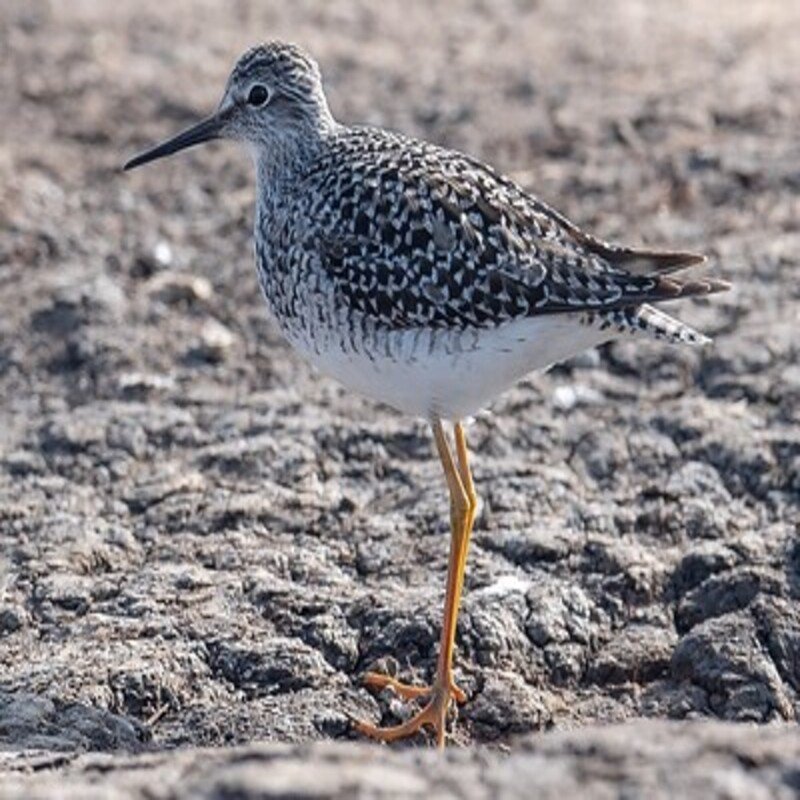The lesser yellowlegs, Tringa flavipes is a shorebird with a medium size. Tringa is the New Latin name given to the green sandpiper by Aldrovandus in 1599. It is derived from the Ancient Greek trungas, a wading bird the size of thrush with a white rump and a tail that bobbles. The specific epithet flavipes comes from the Latin flavus, meaning “yellow,” and pes, meaning “foot.”
Quick Overview: Tringa Flavipes – Lesser Yellowlegs
Body size: Around 10-11 in (25-28 cm) and a weight of 114 g (4.02 oz)
Main colors: Brown, White, Gray, Yellow
Range: Throughout the United States
Migratory Bird: Yes
Best time of the year to see in the U.S.: March, April, May, September, October, November
Conservation Status: Least Concern
Lesser Yellowlegs Description
The lesser yellowlegs is a shorebird of medium size. Its bill is long and straight; its neck is long, and its body is mottled brown with a white belly and a gray rump. Its name comes from its extremely long, bright yellow legs. Males and females have similar appearances.

Size
These birds have a length of 10-11 in (25-28 cm) and a weight of 114 g (4.02 oz). Their wings could range from 19-22 in (48-56 cm).
Feeding
As is the case with other shorebirds, it is almost totally carnivorous, however, it does consume seeds on occasion. Flies and beetles, particularly those found in aquatic settings, are its principal prey.
Habitat
The lesser yellowlegs breed in grassy meadows, bogs, burned-out woodland areas, and other open places or natural clearings during the nesting season. It can be found along the shores of lakes and rivers, in marshy ponds, and in coastal marshes and mudflats during migration and the winter.
Behavior
This species is monogamous during the breeding season; pairs form quickly after arriving on the breeding grounds. Males, frequently in couples or small groups, undertake an undulating flight show in order to attract females to the region as well as to themselves.
Tringa Flavipes Scientific Classification
- Kingdom: Animalia
- Phylum: Chordata
- Subphylum: Chelicerata
- Class: Aves
- Order: Charadriiformes
- Family: Scolopacidae
- Genus: Tringa
- Species: Tringa flavipes
Best time of the year to see
In the United States, the best time of year to see these birds are during the Spring season (March-May) and during the Autumn season (September – November).
Distribution of the Lesser Yellowlegs in the USA
Lesser yellowlegs breed across Alaska’s interior and northern Canada, reaching as far east as central Quebec. The lesser yellowlegs migrate. In the winter, they can be found around North America’s coasts, from New Jersey on the Atlantic to San Francisco Bay on the Pacific, as well as along the Gulf of Mexico and Gulf of California coasts. They spend the winter across the majority of Mexico, Central America, and South America, as well as the Antilles.
The Lesser Yellowlegs can be found in the following states in the United States – Alabama, Alaska, Arizona, Arkansas, Colorado, Connecticut, Delaware, Florida, Georgia, Hawaii, Idaho, Illinois, Indiana, Iowa, Kansas, Kentucky, Louisiana, Maine, Maryland, Massachusetts, Michigan, Minnesota, Mississippi, Missouri, Montana, Nebraska, Nevada, New Hampshire, New Jersey, New Mexico, New York, North Carolina, North Dakota, Ohio, Oklahoma, Oregon, Pennsylvania, Rhode Island, South Carolina, South Dakota, Tennessee, Texas, Utah, Vermont, Virginia, Washington, West Virginia, Wisconsin, and Wyoming.

